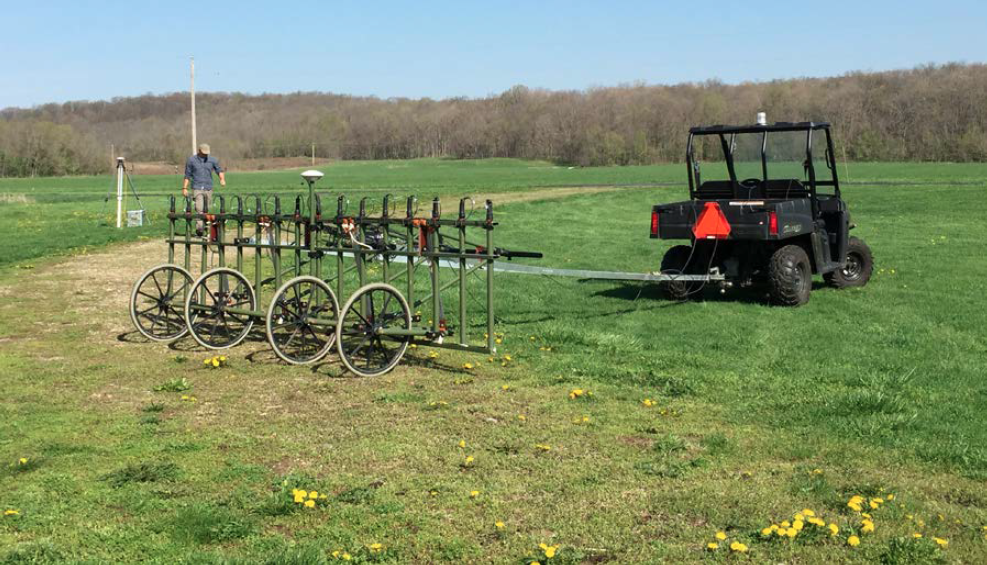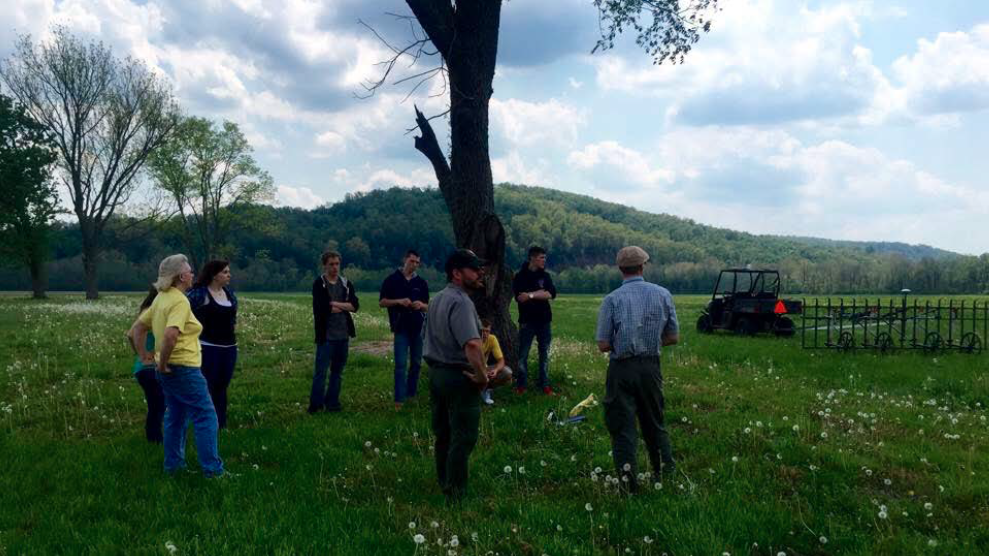Last updated: October 13, 2022
Article
Between the Monuments
Between the Monuments: Large-Scale Geomagnetic Survey at Hopewell Culture National Historical Park, Ross County, Ohio
The purpose of this project was to complete a large-area, high-resolution magnetic survey at the Hopewell Mound Group and Seip Earthworks units of Hopewell Culture National Historical Park. For almost 200 years, archeological research at these monumental geometric earthwork complexes was focused almost exclusively on the associated burial monuments and the remains of funerary rituals contained therein. This project adopted a landscape archeology perspective to investigate the vast spaces “between the monuments,” intended to lead to a more holistic understanding of the full range of domestic and ceremonial activities played out by Scioto Hopewell peoples in and around the earthworks. A secondary goal was to serve as a testbed for the development of a high-resolution, multi-channel, vehicle-towed gradiometer array, and the software necessary to collect and analyze the data.
This project was a one-year, stand-alone effort conducted in accordance with the park’s “Hidden Hopewell Landscapes Archeological Research Framework” (see Ruby 20151). Fieldwork was completed between April 12 – May 20, 2015. The work was permitted under NPS Scientific Research and Collecting Permit #HOCU-2015-SCI-001.
This project was the result of an international research partnership formed in 2015 to conduct landscape-scale geophysical surveys in the park. This is a partnership among Hopewell Culture National Historical Park (HOCU, Dr. Bret Ruby); the German Archaeological Institute, Berlin (DAI, Dr. Friedrich Lüth, Dr. Sebastian Messal, Dr. Rainer Komp); Bournemouth University, UK (BU, Dr. Timothy Darvill); SENSYS GmbH, Berlin (SENSYS, Dr. Andreas Fischer); and Ohio Valley Archaeology, Inc., USA (OVAI, Dr. Jarrod Burks). The NPS will retain copies of all data collected for its use.
All partners participated in research design. Ruby (HOCU) provided assistance with research design and logistical support during fieldwork. Lüth, Messal and Komp (DAI) operated the magnetometer array and performed all data collection and initial data processing. Fischer (SENSYS) provided the prototype magnetometer array, the associated software, and technical support. All partners will participate in the archeological interpretation of the dataset.
The partners contributed all equipment and expertise at no cost to the NPS. The estimated value of the contributions to date is in excess of $400,000. NPS costs were limited to personnel costs for existing staff, fuel, and use of miscellaneous equipment.
The partners successfully collected high-resolution magnetic survey data over nearly 400 acres in the park. The objective to complete a “fenceline-to-fenceline” geomagnetic survey at Hopewell Mound Group and Seip Earthworks was fully accomplished. This is certainly among the largest archeo-geophysical datasets ever recorded in North America. Initial inspection of the data reveals an extraordinary number of anomalies of archeological interest, including newly discovered ditched enclosures, monumental wooden post circles, rectangular building plans, thousands of individual pit features, and a host of others. These data will serve as the basis for more richly detailed interpretations for the scientific community and the visiting public.
A symposium to present preliminary project results will be held at the 81st Annual Meeting of the Society for American Archaeology in Orlando, FL, April 2016. The partners intend to publish a co-authored book to make research results available to the public and research community.
The German team engaged local youth through field demonstrations of the technology to Paint Valley High School students, and a set of graduate-level Pathways Interns working as summer seasonals in the park’s archeology program.
This international collaboration will benefit the NPS through new knowledge and experience in the collection and interpretation of landscape-scale archeo-geophysical datasets that can be used to non-destructively discover and document park resources. NPS will benefit from the DE and UK team members’ experience in interpreting monumental archeological landscapes (esp. Stonehenge) similar to HOCU landscapes. The collaboration will help to establish the integrity and authenticity of HOCU resources for potential nomination to the World Heritage List.
1 Ruby, Bret J. (2015). Hidden Hopewell Landscapes: An Archaeological Research Framework for Hopewell Culture National Historical Park. Research Plan 2015. Manuscript on file, HOCU.
Prepared by: Bret J. Ruby, Archeologist/Chief, Resource Management, Hopewell Culture National Historical Park

NPS/DAI/BU/SENSYS/OVAI

NPS Photo / Susan Knisley

NPS/DAI/BU/SENSYS/OVAI
